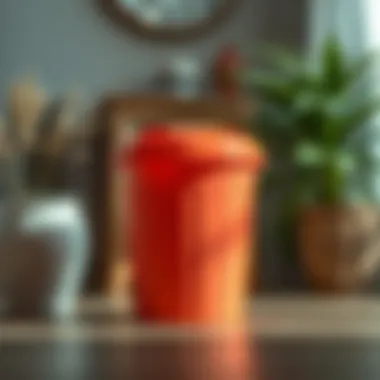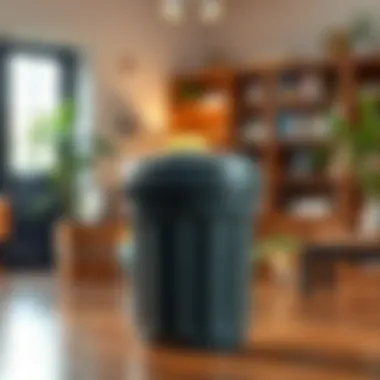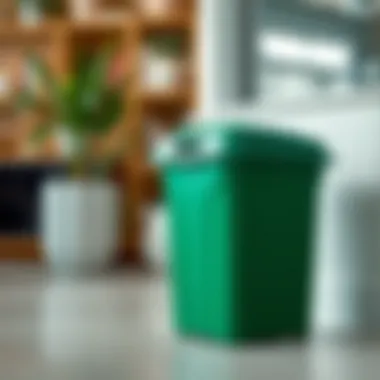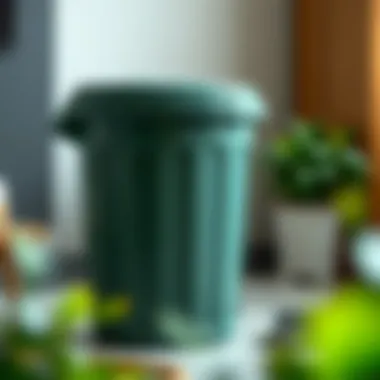The Essential Guide to Small Plastic Trash Bins


Intro
In the modern home, every small detail counts, and one often overlooked item is the humble small plastic trash bin. While it may seem trivial, this item plays a crucial role in maintaining a tidy and organized living space. From kitchens to bathrooms, small trash bins blend functionality and design in ways that are essential for any home. This article explores various aspects of these bins, diving into their designs, materials, functionalities, and their environmental implications.
Understanding the small plastic trash bin is not just about aesthetics; it’s about recognizing its place in contemporary living. As homeowners, designers, and decor enthusiasts seek to create spaces that reflect personal style while also catering to practicality, the choice of trash bin becomes a subtle yet important decision. Through this guide, readers will gain insight into selecting the right bin that complements their home while promoting sustainable living.
Furniture Styles and Trends
As the saying goes, "one man's trash is another man's treasure;" however, the right trash bin can transform what initially appears to be waste into a stunning accent piece within your home. Selecting a trash bin that harmonizes with your home's overall style can elevate the aesthetic of your interiors significantly.
Modern vs. Traditional: Understanding the Aesthetics
When it comes to small plastic trash bins, one can observe two primary stylistic divides: modern and traditional.
Modern designs typically feature clean lines, bold colors, and minimalistic structures. For instance, a sleek white or matte black bin can seamlessly fit into a contemporary kitchen. In contrast, traditional designs often incorporate more classic colors, textured patterns, and a more rounded or ornate shape. They cater to older homes or those aiming for a vintage feel.
The choice between these styles can dictate not only the appearance of your space but also how organized and clean it feels. A mismatched bin can disrupt an otherwise harmonious decor.
Color and Material Trends: What's In and What's Out
The color spectrum available in small plastic trash bins is as vast as the rainbow, ranging from pastel hues to vibrant neons. However, as trends come and go, some colors resonate more with contemporary aesthetics. Currently, muted tones like sage green, soft beige, and light gray are very much in vogue.
Material choice also affects both look and functionality.
- Recyclable Plastics: Eco-friendly choices are becoming increasingly common, reflecting a growing trend towards sustainable living.
- Textured Finishes: These enhance grip and aesthetics, making bins more attractive while also practical.
- Bamboo Accents: Combined with plastic bodies, they offer a stylish blend of modernity and nature.
These trends suggest that there’s more to a trash bin than meets the eye; they are not merely containers but pivotal decor elements that contribute to the overall atmosphere of a room.
Furniture Care and Maintenance
While selecting a stylish trash bin is one thing, maintaining it is another ball game. Therefore, understanding how to care for your small plastic bin ensures longevity and continued aesthetic appeal.
Tips for Prolonging the Life of Your Furniture
- Regular Cleaning: Wipe down your bins weekly to avoid buildup of grime or odors.
- Choose Proper Placement: Locate bins in low-traffic areas to prevent unintentional damage.
- Avoid Overpacking: Keeping the bin filled to the brim can cause wear and tear over time.
DIY Repair Hacks for Common Furniture Issues
Small plastic bins might not require extensive repairs, but here are a few handy tricks:
- Dents and Dings: Use a hairdryer to gently heat the area that has been dented, then press out the dent with your hand.
- Scuff Marks: For marks that stubbornly cling, a mixture of baking soda and vinegar often works wonders.
By adhering to these maintenance tips, homeowners can ensure that their small plastic trash bins not only serve their purpose well but also complement their living spaces for years to come.
"Functionality can beautifully coexist with design; it's all about finding that sweet spot."
Now that we've explored essential styles, trends, and maintenance tips for small plastic trash bins, readers are equipped with the knowledge to make informed decisions about integrating these functional pieces into their homes. This guide sets the groundwork for creating a well-organized, stylish environment that leaves a positive impression.
Understanding Small Plastic Trash Bins
Small plastic trash bins are a quintessential element in maintaining order within our living spaces. Not only do they serve the obvious function of waste management, but they also play a crucial role in upholding aesthetics in home design. With an increasing awareness of sustainability and functional design, understanding these bins is essential for homeowners, designers, and even retailers.
Definition and Purpose
A small plastic trash bin is typically defined as a container made from various types of plastic, designed primarily to collect and hold waste materials. Their purpose goes beyond simple disposal; they are strategically placed in various areas of the home to facilitate garbage collection without detracting from the overall decor. Whether it's in the kitchen, bathroom, or home office, these bins are tailored to fit specific spaces and needs. Ideally, they should combine functionality with an appealing design that harmonizes with one's interior.
For instance, a small plastic bin in a sleek black finish might complement a modern kitchen, while one with a vibrant floral design could brighten a child’s room. The versatility of these bins allows them to be both practical and aesthetically pleasing, catering to a wide range of preferences and requirements.
Additionally, small plastic trash bins contribute to cleanliness and hygiene. They offer a designated space for waste, which encourages proper disposal habits and minimizes clutter. Without such containers, rubbish can easily accumulate, leading to unsightly messes and potential health hazards.
Historical Context
Tracing back the origins of trash bins, one finds a fascinating evolution. In the earlier days, refuse was often discarded in simple holes or thrown into the streets. However, as urbanization took hold, the necessity for organized waste management systems revealed itself. The invention of the trash bin can be linked to the mid-19th century when the industrial revolution brought about rapid changes in society and lifestyles.
Over the decades, trash bins have shifted from materials such as wood and metal to the more versatile and affordable plastics we see today. This transition marked a significant turning point, allowing for bins that are not only functional but also lightweight and easier to clean. The simple design of modern small plastic trash bins reflects this evolution, often incorporating features like handles or foot pedals for added convenience.
In recent years, there has been a notable shift towards environmentally friendly options, as more consumers become aware of the impact of plastic waste on our planet. This historical context underscores the bin's journey from basic waste receptacles to thoughtful design elements that contribute to both convenience and sustainability in contemporary homes.
"The evolution of the trash bin mirrors society's changing attitudes towards waste management and environmental responsibility."
Through understanding the definition and purpose, along with the historical context of small plastic trash bins, individuals can appreciate not only their functional attributes but also their placement within the broader narrative of consumer habits and design aesthetics.
Material Considerations
When it comes to small plastic trash bins, the materials selected hold significant weight in terms of functionality and durability. Understanding the composition of these bins provides insights into their lifecycle, usability, and even aesthetic appeal in various settings. The choice of material impacts everything from strength to environmental sustainability, making this section vital for homeowners, designers, and anyone interested in the particulars of interior design.
Types of Plastic Used
Polyethylene
Polyethylene is often the go-to choice for small plastic trash bins, largely due to its impressive resistance to impact and moisture. Made from ethylene, it’s a lightweight yet resilient plastic that can handle everyday wear and tear. One key characteristic of polyethylene is its flexibility; this means even if it’s dropped or knocked over, it tends to hold its shape and function well, which is an essential feature for a bin that frequently sees use.


The unique feature of polyethylene is its ability to be produced in various densities, such as low-density polyethylene (LDPE) and high-density polyethylene (HDPE). While LDPE is softer and more flexible, HDPE is stronger and more rigid, which often makes it a preferred option for trash bins. A significant advantage of polyethylene is its resistance to various chemicals, which ensures that even the messiest of disposals won't break the bin down. However, one drawback is its susceptibility to UV light. Over time, exposure can cause the material to degrade if left in direct sunlight for prolonged periods.
Polypropylene
Another popular choice is polypropylene, which stands out due to its higher melting point compared to polyethylene, allowing it to be used in settings that see more abuse. This characteristic makes polypropylene an excellent fit for trash bins that may need to hold hot or higher-temperature contents. Its rigidity is a distinct feature that contributes to its durability; this makes it less likely to sag or warp compared to some softer plastics.
Polypropylene's sleek appearance can also lend itself more readily to modern design philosophies. Its production can be cleaner from an environmental standpoint, often being made from ‘virgin’ materials or recycled sources. However, it’s not entirely without drawbacks. For instance, it can be more prone to scratching, which might affect its visual appeal over time.
Recycled Plastics
Recycled plastics have gained popularity in recent years as sustainability has become a big buzzword in both design and manufacturing industries. These plastics are sourced from post-consumer waste, offering a second life to materials that would otherwise end up in landfills. A significant advantage of recycled plastics is their lower environmental impact; using these materials reduces the demand for virgin plastics and supports a circular economy.
A unique feature of bins made from recycled plastics is their often multi-colored or speckled appearance, which can add an artistic flair to designs. They tend to vary in texture and quality depending on the sources of the raw materials used. This can make them a more cost-effective and accessible option for many consumers. The downside, however, can be inconsistent quality and durability issues depending on the recycling processes involved.
Durability and Lifespan
Understanding the durability and lifespan of a small plastic trash bin is crucial, particularly when assessing its value. The average lifespan of these bins can vary depending on the materials used, care provided, and the environment they are placed in. Bins made of high-quality polyethylene or polypropylene generally offer longer service, often withstanding several years of daily use without succumbing to significant wear.
Regular maintenance can further extend their lifespan. Periodic cleanings and avoiding abrasive materials when scrubbing can keep the bins in good shape.
For the conscientious consumer, short-term costs must be balanced against long-term savings. Investing in durable materials can mean fewer replacements down the line, proving to be a financially sound choice.
In summary, the choice of material impacts not just functionality and longevity but also aesthetics and environmental considerations, making it a cornerstone of every small plastic trash bin's design.
Design Variations
Design variations in small plastic trash bins play an essential role in how they fit into an interior space. These bins are not merely functional items but also contribute to the overall aesthetic of a room. Understanding the different design aspects—aspects such as color, shape, size, and texture—allows homeowners and designers to choose products that not only serve their purpose effectively but also enhance the environment they occupy.
Color and Aesthetic Choices
Neutral Tones
Neutral tones like whites, grays, and beiges are often favored in many homes due to their versatility. They blend seamlessly with various decor styles, whether contemporary or traditional. For example, a soft gray bin could complement a rustic kitchen or a modern office space, keeping the focus on the surrounding decor. The key characteristic of neutral tones lies in their ability to provide a calm and unobtrusive backdrop.
However, while they bring cohesion, they can lack personality. Homeowners should balance this aspect by combining these bins with more colorful accessories or artwork to keep the space engaging.
Vibrant Colors
Conversely, vibrant colors such as bright yellows, reds, and blues can make a bold statement in a space. These hues are particularly effective in children's rooms or kitchens that aim for a cheerful atmosphere. A vivid red trash bin can serve not only as a functional object but also as a pop of color amid more muted elements. The unique feature of vibrant colors is their ability to energize a space, yet they may overpower subtle designs. Care must be taken to ensure these eye-catching bins don’t clash with other elements in the room.
Textured Finishes
Textured finishes introduce an additional layer of visual interest to small plastic trash bins. Whether it’s a matte finish that absorbs light or a glossy one that reflects it, texture can enhance a bin’s appeal. For example, a matte black bin can add a touch of sophistication, while a glossy finish might bring forth a modern vibe. This aspect is beneficial since it can serve functional versatility while enhancing the visual decor. However, textured surfaces might be trickier to keep clean, which is a point for consideration.
Shape and Size Options
Traditional Round
The traditional round shape has been a staple in trash bin design for years. Commonly used in homes and offices, round bins are space-efficient and easy to position in corners or along walls. Their classic design fits well with various styles, from vintage to ultra-modern. One of their prime characteristics is the ease of access when tossing in waste; there’s little worry about angles or edges. However, while they are practical, their space-saving ability might not suit all room dimensions, especially in tighter spaces where a square shape may provide better fitting.
Contemporary Square
Square bins have gained popularity due to their design coherence with modern furniture. With clean lines and edges, they can contribute to a geometric aesthetic that many contemporary spaces seek. A square plastic trash bin can easily be moved into a cubby or a corner, optimizing space allocation. Notably, their notable feature is their uniformity, making them ideal for stackable storage options. On the downside, they might not offer the same accessibility as round bins, particularly in smaller rooms where space becomes cramped.
Compact Models
As living spaces become more compact, the demand for smaller trash bins is on the rise. Compact models cater specifically to this need, designed to fit under desks, in tight kitchen corners, or within bathroom cabinets. Their key characteristic lies in sleek designs that maintain functionality without sacrificing precious space. For instance, a compact bin can often have features like a built-in lid or a slide-out system, providing added convenience. The downside is that these bins typically have limited capacity, which may not be suitable for households producing more waste.
Knowing your space and its design is paramount when choosing the right trash bin. Selecting the right combination of color, shape, and size ensures that these necessary items become part of your home decor rather than distractions.
In summary, the design variations available for small plastic trash bins are crucial not only for functionality but also for their role in the aesthetics of a home. From neutral tones that blend in seamlessly to vibrant colors that make a statement and diverse shapes that meet specific needs, every aspect contributes to the overall ambiance of interior design.
Functional Aspects of Small Plastic Trash Bins
Small plastic trash bins serve functions that are essential yet often overlooked in the design of our interiors. While they might seem trivial, their functionality can significantly affect organization and cleanliness in various spaces. Understanding the unique traits of these bins helps homeowners, designers, and DIY enthusiasts make better choices about which one fits their environment best.
Capacity and Versatility
When it comes to capacity, small plastic trash bins come in different sizes, typically ranging from about 2 to 10 gallons. This variety allows them to fit comfortably in diverse spaces, from kitchens to home offices. Not only do they need to hold waste, but they also have to accommodate the varying volumes of trash generated in these areas. For instance, a small kitchen bin may require more frequent emptying due to the higher volume of kitchen scraps, while a bathroom bin may be predominantly used for recyclable items, like empty product containers. Hence, choosing the right capacity is all about assessing one's need against the space constraints available.
In addition to capacity, versatility plays a crucial role. Some bins are meant solely for waste, while others can double as storage units, particularly in rooms where aesthetics matter. A compact, stylish bin that blends seamlessly with home decor can prevent clutter while serving its primary purpose, hence enhancing functionality and visual appeal.
Lid Mechanisms and Odor Control
An effective lid mechanism is crucial for controlling odors and ensuring sanitary use of plastic trash bins. Different lid designs offer unique benefits:
Swing Top
The swing top is a classic choice, often found in residential and commercial settings alike. Its key characteristic lies in the simplicity of its operation; a gentle push is all it takes to open. This makes it appealing for quick waste disposal, especially in busy kitchens. The unique feature of swing tops is that they can be left open for easy access or closed to keep odors contained. However, they do come with a downside; if not sealed properly, they may not contain strong smells, especially from food waste, justifying the need for the right material and design in this context.
Step Pedal


The step pedal is another popular mechanism, celebrated for its hands-free operation. Users can simply press down with their foot to access the bin. This is a significant advantage in preventing direct contact with the lid, which is paramount for hygiene. However, while step pedals are generally considered more sanitary, they do require regular maintenance as the moving parts can wear down over time and may need lubrication or replacement. This extra effort can be seen as a disadvantage for some, though the benefits often outweigh the downsides for heavy users.
Push Lid
Lastly, the push lid offers a straightforward design that prioritizes ease of use. Users can press to open the lid and release to close it, an action that often prevents odors from escaping. A primary advantage of this design is its simplicity, which translates into a more streamlined look that can complement a variety of decor styles. However, some might find that push lids require more effort to open than swing tops, especially when the hands are full or dirty.
Placement in Interior Design
Understanding where small plastic trash bins fit within the landscape of interior design offers invaluable insights into maintaining a well-organized and aesthetically pleasing environment. The strategic placement of these bins can enhance functionality without compromising the overall look of a space. By considering important factors like accessibility, size, and style, homeowners and designers can make informed decisions that align with both practicality and decor.
Ideal Locations
Kitchen
The kitchen is truly the heart of the home and one ideal spot for small plastic trash bins. Not only does it help maintain cleanliness, but it also contributes to the kitchen's workflow. An easily accessible bin encourages efficient waste disposal while preparing meals, keeping the counters free of clutter and mess. Key characteristics to note include size; opting for a bin that fits seamlessly under the sink or in a corner can be particularly beneficial.
A unique feature of kitchen bins lies in the variety of designs available. From bins that coordinate with the cabinetry to those that integrate advanced odor control systems, the options are vast. However, one must be cautious about choosing bins with inadequate capacity, which might require more frequent changes and disrupt kitchen activities.
Home Office
In a home office, maintaining a tidy workspace is crucial for productivity. A small plastic trash bin can play a significant role in keeping physical documents and other clutter in check, making it easier to focus on tasks at hand. The aesthetic aspect is vital here; selecting a design that complements the overall office theme lends a professional touch. Compact models can fit neatly next to a desk without hogging space, proving popular among professionals seeking efficiency in design.
Nevertheless, one should consider the type of materials discarded, such as paper or packaging, as this might impact the bin's choice. Furthermore, bins in home offices often demand more frequent maintenance, as documents can pile up quickly without proper disposal habits.
Bathroom
Small plastic trash bins are indispensable in bathrooms, serving a dual purpose of maintaining personal hygiene and coordinating with decor. The nature of bathroom waste often calls for a design that can handle both disposal needs and aesthetic appeal. Bathrooms tend to use vibrant or neutral color tones, so it’s beneficial to select a bin that aligns with these themes. An essential aspect includes bins with lids, which can help contain unpleasant odors, essential for maintaining a fresh environment.
However, with limited floor space available in many bathrooms, finding the right spot for a bin can be tricky. Compact or corner bins designed for smaller areas can be useful in optimizing space without sacrificing functionality.
Integration with Decor
Complementing Color Schemes
Choosing a small plastic trash bin that complements existing color schemes can elevate the overall look of a room. This aspect is not just about aesthetics; it enhances the harmony within the space. Integrating colors that match or subtly contrast the decor can unify various elements in the room, emphasizing personal style.
Nonetheless, there is a risk of being too focused on color, potentially overlooking the functionality of the bin itself. Ensuring quality alongside aesthetics is paramount for a durable choice that stands the test of time.
Harmonizing Styles
Integrating bins that harmonize with existing style trends is important in today's diverse design landscapes. Whether you lean towards minimalist, modern or rustic themes, small plastic trash bins are available to suit these styles. Highlighting modern design benefits, such as clean lines and a sleek finish, can complement and enhance overall design.
However, one must avoid bins that clash with the chosen theme. A mismatched bin can distract from an otherwise cohesive decor strategy, making it essential to balance style preferences with utility.
Camouflaging Trash Bins
Camouflaging trash bins can be a clever solution, allowing homeowners to maintain a clutter-free environment while subtly hiding waste disposal units. Choosing designs that mimic decorative features, such as planters or storage solutions, can effectively disguise their presence while still offering functionality.
The unique advantage here includes a seamless transition from practical elements to aesthetic features in a room. It's fascinating how a well-placed trash bin can contribute to perceived tidiness and organization. Nevertheless, it's crucial to ensure that accessibility isn't sacrificed for decorative purposes, as it might defeat the bin's role in everyday use.
In summary, the careful consideration of placement and integration of small plastic trash bins within interior spaces can significantly influence both function and style. By selecting ideal locations and harmonizing design elements, these bins become more than mere waste receptacles; they evolve into essential components of a well-designed home.
Sustainability Considerations
In today’s world, the push for sustainability is more than just a fad; it’s a necessity. The small plastic trash bin, while often overlooked, plays its own significant role in this global narrative. Understanding its environmental impact provides much-needed insights into the choices consumers and manufacturers must make to foster a greener future. By examining the recyclability of plastic and exploring alternative eco-friendly options, we can comprehend how these bins align with or challenge sustainable living goals.
Recyclability of Plastic
When talking about sustainability, recyclability of plastics stands at the forefront. Plastic trash bins, especially those made from certain types of polyethylenes and polypropylenes, can be recycled, reducing waste and conserving resources. This is crucial for reducing landfill overflow, a situation that’s far too common in many urban areas.
However, the reality isn’t all sunshine and rainbows. Not every recycling facility accepts plastic bins due to contamination issues and the type of plastics used. Ensuring proper disposal, along with checking local recycling guidelines, can greatly enhance the effectiveness of recycling. This highlights a key point: consumers need to be informed about their local waste management practices to make the most sustainable choices.
"If you're gonna use plastic, using what's easily recyclable is your best bet. Every little bit helps in turning the tide of waste."
Alternative Eco-Friendly Options
Though plastic bins have certain merits, there are emerging alternatives that align better with eco-friendly living. Let’s delve into a few of these choices:
Bamboo Bin
Bamboo bins are swiftly gaining attention as a sustainable alternative. This material is renowned for its rapid growth and renewability, making it an eco-conscious choice. A key characteristic of bamboo bins is their biodegradability, allowing them to decompose after their useful life rather than persisting in landfills for decades.
One unique feature of bamboo bins is their aesthetic appeal. They blend well with various interior styles, adding a natural touch to spaces without compromising on functionality. However, it's worth noting that bamboo can require more care to prevent warping from moisture, which may limit its use in high-humidity areas like bathrooms.
Compost Bins
Compost bins present another exemplary option for environmentally-conscious individuals. They allow organic waste to decompose naturally, creating nutrient-rich compost that can benefit gardens and household plants. The key characteristic of compost bins is their ability to divert organic waste from landfills, greatly reducing methane emissions associated with waste decomposition under anaerobic conditions.
A unique feature of many compost bins is their aeration system, which encourages efficient composting. However, they may need regular maintenance to ensure effective composting processes, which some homeowners might find cumbersome.


Metal Alternatives
Metal bins, often made from stainless steel or aluminum, provide a durable alternative to plastic. They are generally more robust and resistant to wear and tear, enhancing their longevity compared to plastic options. These bins boast the key trait of being fully recyclable, not only in principle but also in practice, as they are commonly accepted at most recycling facilities.
One unique feature of metal bins is their natural resistance to odors, often making them a preferred option for areas with heavy waste, such as kitchens. Yet, they can be heavier than plastic, making them a bit cumbersome for some users. Additionally, metal containers may be prone to rust if not properly cared for, particularly in moist environments.
Maintenance and Care
In the grand scheme of things, small plastic trash bins often get a bad rap. They’re the unsung heroes of cleanliness, silently standing in corners, tucked away under desks or sitting pretty in kitchens. However, without proper maintenance and care, these practical devices can become breeding grounds for odors and bacteria. Keeping these bins clean isn’t just about aesthetics; it’s essential for health and hygiene within the home. Regular maintenance ensures that these items not only function effectively but also enhance the overall ambiance of your living space.
Cleaning Techniques
Regular Disinfecting
Regular disinfecting is crucial. It’s like giving your trash bin a routine health check. Over time, even the best of bins can collect gunk—food residue, dirt, and even microscopic invaders. By using disinfectants, you minimize the build-up of harmful bacteria. A key characteristic of regular disinfecting is its ability to sanitize surfaces effectively. This practice is popular because it protects your family from health risks associated with common household germs.
What sets regular disinfecting apart is its unique feature of retaining freshness. While an occasional wipe with a damp cloth may clear visible grime, using proper disinfectants can eliminate odors at the source. However, a downside could be that using strong chemicals can leave residues; thus, careful selection is vital. Opt for environmentally-friendly disinfectants when possible, balancing safety with effectiveness.
Removing Stains
Removing stains from small plastic trash bins should not be an afterthought. Stains, whether from red sauces or greasy leftovers, can make even the most stylish bin look untidy. The act of removing stains not only restores aesthetic appeal but also contributes to hygiene. A key part of this process is that it can be achieved using common household items, such as baking soda or vinegar. This makes it a must-try for homeowners who want to save on expensive cleaning products.
Unique features in stain removal techniques include leveraging the gentle abrasive feel of baking soda, which can lift stains without scratching the surface of your bin. However, it’s wise to consider that some stains may require more elbow grease than others, potentially leading to surface wear over time. So, timely action is the name of the game.
Deodorization Methods
Deodorization keeps that unpleasant trash smell at bay. The common misconception is that merely emptying the trash is enough, but odors linger long after the bag is gone. Deodorization methods involve incorporating elements like baking soda or activated charcoal directly into the bin. This makes it a beneficial choice for those especially sensitive to odors, such as young families or pet owners.
The unique feature of these methods is their quick action; sprinkle some baking soda in your bin, and you’ll notice a difference almost immediately. However, one must also be aware that some deodorization methods may require more frequent renewal than others, adding a small amount of ongoing maintenance.
Longevity Tips
To ensure that your small plastic trash bin has a long and productive life, here are some longevity tips to consider:
- Use liners: Utilizing liners can protect the interior of your trash bin, making cleaning a breeze.
- Regular checks: Inspect your bin for cracks or wear, addressing any issues before they become major problems.
- Avoid excessive weight: Don't overload your bin, which can lead to damage and warping.
- Store wisely: Keep your bin in a stable, dry place to avoid exposure to extreme temperatures that can degrade the plastic.
By implementing these maintenance strategies, homeowners can ensure that small plastic trash bins remain functional, stylish, and valuable assets in home design.
Consumer Trends
Understanding consumer trends is crucial in shaping the market of small plastic trash bins. As habits shift and values evolve, homeowners and designers alike are looking for products that not only serve a functional purpose but also align with their ethos and lifestyles. In examining these trends, we can identify preferences that reflect a growing consciousness towards sustainability, efficiency, and aesthetics in design.
Market Preferences
In recent years, there has been a marked shift in how consumers choose small plastic trash bins. Instead of merely focusing on price and utility, many now seek multi-functional options that cater to more than one need. In a busy kitchen, for instance, a trash bin that doubles as a compost container can appeal to eco-conscious homeowners.
- Compactness is King: Space-saving designs are increasingly favored, especially in urban living situations where real estate comes at a premium. Consumers are drawn to bins that fit snugly under countertops or in tight corners, allowing for efficient use of space.
- Aesthetic Appeal: Color and design are more than just the cherry on top. Shoppers want bins that can blend seamlessly with their home decor, leading to increased demand for unique designs and customizable options.
- Material Preference: With a heightened awareness of environmental issues, there's a noticeable lean towards recycled materials. This trend not only helps the planet but also adds an element of uniqueness to each product since they’re often made from post-consumer waste.
These preferences are not just trends; they indicate a broader shift in consumer values where practicality meets environmental and aesthetic consciousness.
Influence of Technology
Technology is increasingly becoming a key player in enhancing the functionality of small plastic trash bins. With consumers being more connected than ever, the integration of technology into everyday objects isn’t just a novelty; it’s becoming a necessity. Two significant advancements in this domain are Smart Trash Bins and sensor-enabled features.
Smart Trash Bins
Smart Trash Bins offer a glimpse into the future of waste management at home. These bins can be connected to an app on your mobile device, enabling features like tracking waste output, reminders for collection days, or even alerts when the bin is full. A standout aspect of smart bins is their ability to streamline waste sorting—some models can even identify what type of waste is being disposed of, suggesting ways to recycle or compost effectively.
- Benefits: The convenience factors heavily here. If a family is busy and kids often forget to sort trash, a smart bin can minimize the hassle and errors associated with waste management.
- Unique Feature: Many of these bins come equipped with built-in scales to help track waste over time, encouraging more mindful consumption. Disadvantages can include the price point—these bins are generally more expensive than traditional options.
Sensor-enabled Features
Sensor-enabled features are elevating the trash bin experience, making them much more hygienic and user-friendly. With a simple wave of the hand, the lid opens automatically, reducing the need for physical contact with the bin. This is particularly appealing for kitchens where cleanliness is paramount. The sensors can also be programmed to reduce odor, essential for maintaining a fresh atmosphere.
- Key Characteristic: The hands-free operation makes these bins especially appealing for families with young children and individuals with limited mobility.
- Advantages: Aside from hygiene, these features promote ease of access and can be less messy, preventing spills.
- Disadvantages: However, like smart bins, sensor-enabled trash bins may require batteries or be reliant on electricity, which could be a concern for some users.
In summary, as consumers increasingly lean towards innovation in design and technology, the market for small plastic trash bins will continue to evolve. Understanding these trends not only provides insights into consumer behavior but also helps manufacturers align their products with the future demands of the market.
The End and Future Directions
As we delve into the world of small plastic trash bins, it's clear that these everyday objects serve more than just a utilitarian purpose. They are indeed a reflection of our evolving relationship with space, cleanliness, and sustainability. Recognizing their diverse functionalities, from color choices that enhance decor to innovative designs that tackle odor management, it becomes essential to appreciate the role they play in our lives. Homeowners, designers, and DIY enthusiasts should weigh not only the aesthetic appeal of these bins but also their impact on the environment, paving the way for more mindful consumption and better stewardship of resources.
Recap of Key Points
Throughout our exploration, several key points emerged regarding small plastic trash bins:
- Functionality is paramount; bins must accommodate various spaces and needs without sacrificing style.
- Material choices greatly affect durability, with variations like polyethylene and recycled plastics making sustainability more achievable.
- Design variations cater to personal tastes and home aesthetics, blending seamlessly into environments.
- Maintenance is crucial; keeping trash bins clean ensures longevity and hygiene, while proper care can also mitigate unpleasant smells.
- Consumer trends reflect a shift towards smart technology that enhances convenience.
With these insights, it's clear that small plastic trash bins are not merely waste holders but can be integrated thoughtfully into our living spaces.
Emerging Innovations
The future of small plastic trash bins looks bright, propelled by advancements in technology and design. Here are some notable trends shaping their evolution:
- Smart trash bins: As homes become increasingly interconnected, the rise of smart trash bins equipped with sensors to detect when they're full promises greater efficiency and convenience. These bins could notify users when it’s time to take out the trash or even sort waste automatically.
- Biodegradable materials: As environmental awareness grows, the shift to biodegradable plastics could revolutionize waste containment. Innovations in materials science are paving the way for trash bins that break down naturally, reducing landfill impact.
- Modular designs: Modular bins, which can be adjusted in size or function, allow for personalization based on individual needs or specific uses, catering more effectively to diverse households.
- Design collaborations: As brands collaborate with designers, we can expect stylish yet functional bins that transcend traditional design norms, creating conversation pieces rather than mere storage solutions.
Ultimately, the small plastic trash bin remains a vital component of modern life. By staying informed about the latest designs and technologies, consumers can make choices that enhance their living spaces while supporting sustainable practices.















